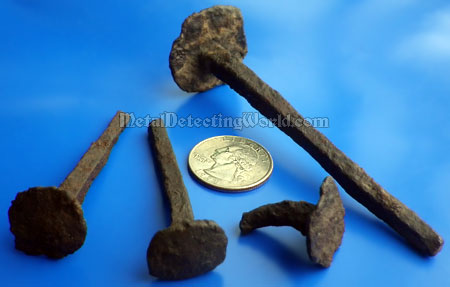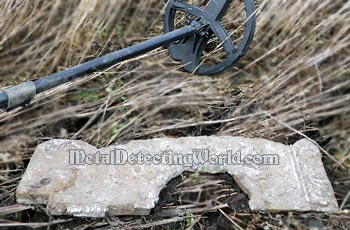PART II: Metal Detecting with XP Deus - Practical Tips for Users, page 3
How To Recognize False Coin-Like Signals with XP Deus
B) False Signals of Coin-Like type
This type of high-pitched responses to targets can be divided in two subcategories: IRON FALSING and GROUND FALSING.
B-1) False Signals Caused by Iron - IRON FALSING:
Most Iron Falsing is caused by Halo-Effect (you may want to read details about Halo Effect here).
All iron objects that have been underground for long periods of time can induce a high-tone/iron-buzzed response in the Deus' discriminate circuit due to the long-developed Halo Effects around them. The high-pitched tone ALWAYS accompanies the iron 'buzz' and is as strong as the latter; thus, producing FALSE (high-pitched tone) or "MIXED" (high-pitched tone/iron buzz) FALSE signals called Iron Falsing.
Iron target's Oxidation/Rust may also cause Iron Falsing. Iron and iron alloys can rust to a high degree making the Deus' discrimination circuit register iron objects as the targets with both conductive and ferrous properties. This results in appearance of alternating (bouncing) high/low VDI read-outs on a screen and in appearance of the high-pitched tone (assigned to non-ferrous desirable targets) in audio responses.
Here are basic types of the Deus' responses to Iron Falsing:
1. "One-Way Repeatable" High-Tone/Iron-Buzz Signals
- If the high-tone signal is "one-way repeatable", you should do the following steps:
- 1) Use the coil-wiggling technique (described on previous page) to isolate the high-tone signal without losing it. If the good signal can not be separated from the iron buzz, do step 2.
- 2) Simply make a 90° turn on a target spot and sweep a search coil again. The high-pitched response should disappear, and the target is iron. If the good signal is still accompanied with the iron buzz, do the next step.
- 3) Use the Crush-Halo Technique: stab the shovel blade half way into the ground a few inches away from the target (make sure you have pinpointed it correctly) not to damage it. Then wiggle the shovel blade a little to break up the Halo Effect. If the high-pitched signal disappears, move on. But if the Deus still responds to the target with a high-tone/iron buzzed signal, dig up the target!
NOTE: In many cases, rusty wrought iron nails with LARGE HEADS (shown with a US 25-cent coin for size reference below) and medium-sized square nails (cast iron) can induce high-pitched audio responses of the Coin-Like type or at least "iron crackling" until they are actually dug up.

Wrought Iron Nails with Large Heads
2. "Two-Way Repeatable" High-Tone/Iron-Buzz Signals
If the high-tone/iron buzzed signal is "two-way repeatable", you should follow the same steps 1, 2 and 3 described above. But, first, you should determine whether or not you have encountered some large iron which most likely will give you a "hollow" loud-sounding (this is when the Overload feature comes into play) Coin-Like signal of a "large" size.
2-1.Large iron objects will sound off with a good signal even after being dug up because the target size always affects conductivity rating for objects: the larger the target, the higher the corresponding conductivity rating. The strong iron buzz (Iron Volume should be set accordingly) and low VDI numbers will be the only indication of the object's iron properties.

This Dug Fragment of WW2 Tank Armor
Sounded Off with High-Tone Signal
It is up to you to decide what to do with such a target. Depending on your hunt site's history, this large target may be just a military junk like an armor fragment shown above or.. a large iron pot full of coins. I would recommend you to recover large iron targets in any case because any of them may also be a coin cache protector - an iron object, a padlock or a door latch, that was usually placed on top of a buried treasure for protection against diggers (according to medieval superstition). Same way, the large iron targets may mask a few valuable coins lying underneath.